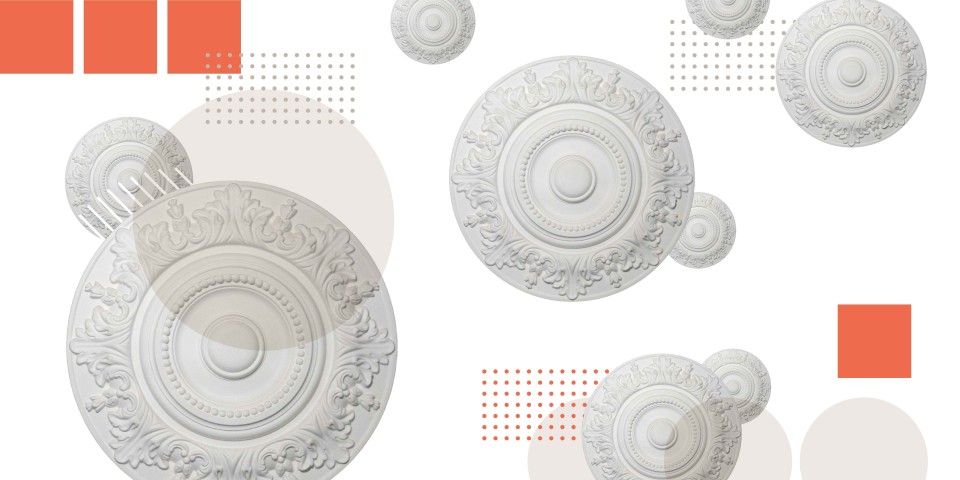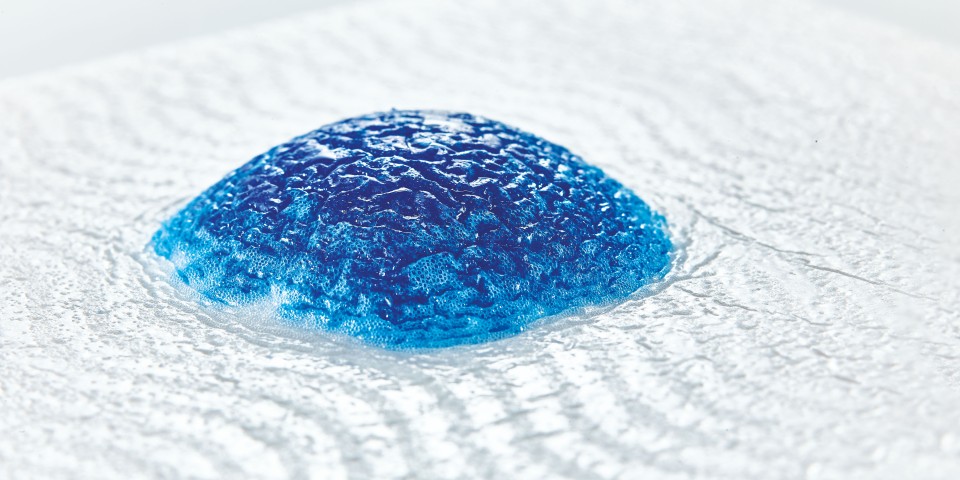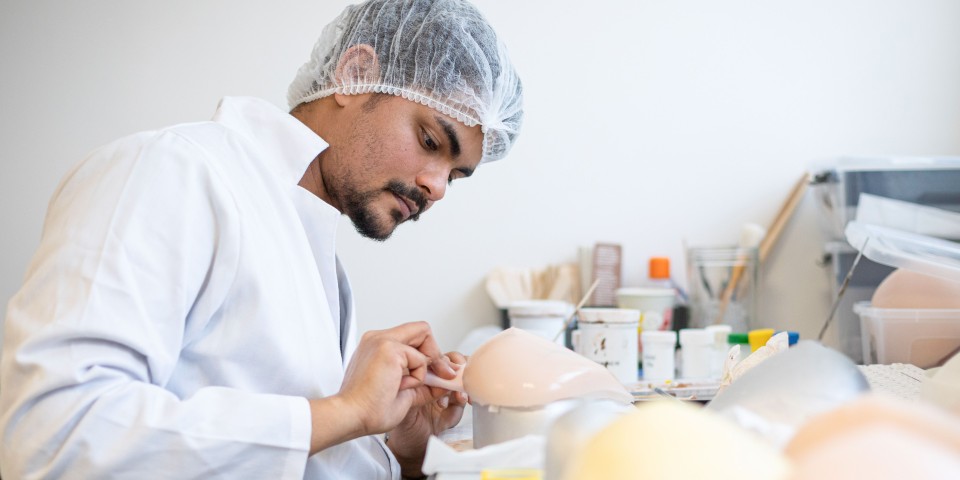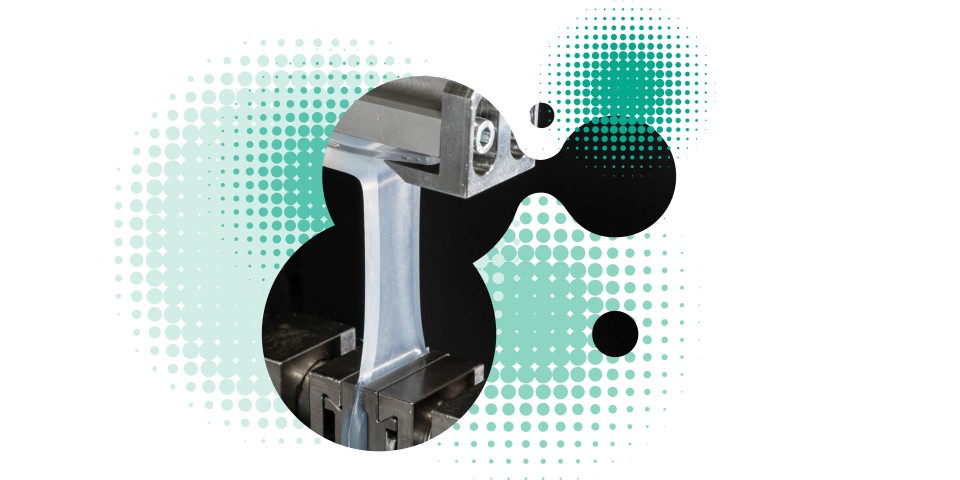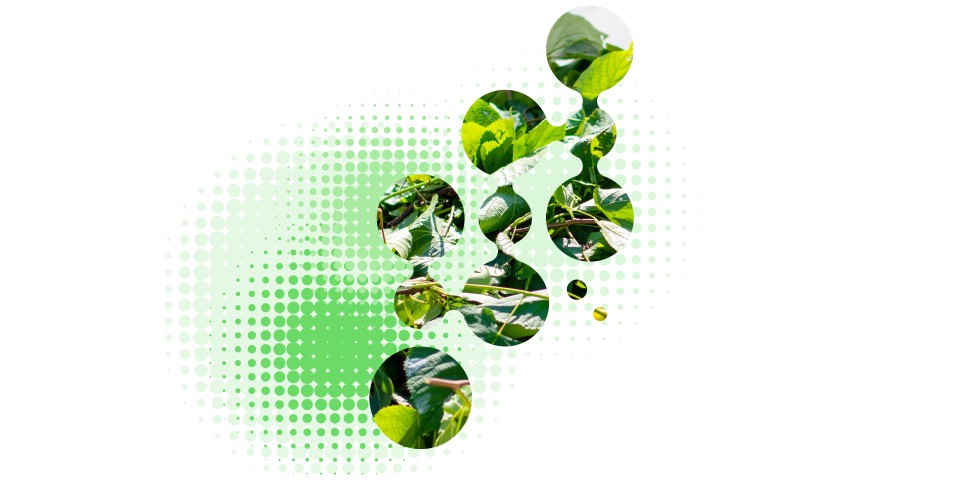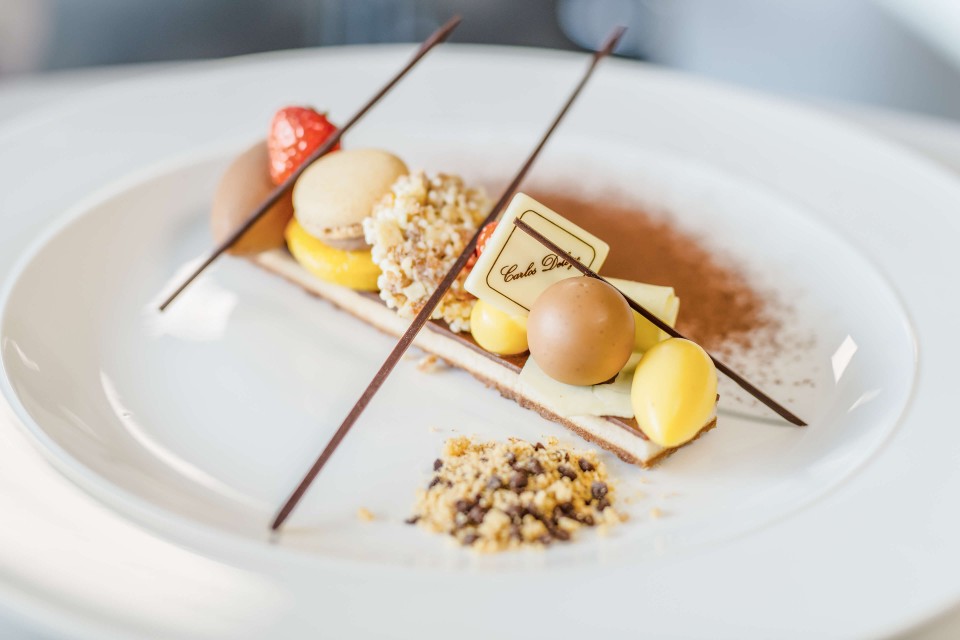
Imaginatively molded 3D desserts
Oct 01, 2019 Read time: approx. MinutesMinute
A visual treat
With his imaginatively molded 3D desserts, Belgian pastry chef Carlos Deleye has worked his way into the ranks of the top suppliers to the gourmet foods industry. He owes his success to a grade of WACKER silicone rubber approved for food production.
The tall, silver, stainless-steel pot of freshly mixed panna cotta cream is ready, as is the twelve-cavity silicone baking mold. Dressed in his white uniform, the pastry chef swings into action: he dips a big ladle into the viscous mixture one, two, three times and then pours the sweet contents onto the flat template. He jiggles the mold with his right hand, and the light-yellow cream automatically distributes into the round cavities. In his left hand, he holds a long icing knife and helps the process along with smooth spreading motions. In less than thirty seconds, the delicious treat has spread into the mold’s nooks and crannies. He finishes with a few Carlos Deleye, pastry chef more forceful shakes to burst any air bubbles and to fill in the last remaining open spaces. Then, with a practiced hand, he brushes a spatula across the top to remove any residual batter from the mold. All done.
The twelve identical white circles now make a decorative contrast to the terracottacolored baking mold, and their next stop is the freezer. “We freeze the panna cotta rings at minus 35 to 40 degrees Celsius,” explains Carlos Deleye, CEO of the company he founded. A tall Belgian with short hair and bright blue eyes, Deleye employs around 40 people at his site in Mouscron in the Wallonia region of Belgium, which is near the French border and only about 20 km from the city of Lille in northern France. The factory, a quite imposing facility covering 6,000 square meters, produces desserts and small, bitesized appetizers known as amuse-gueules. The Deleye company offers some 120 different frozen foods, which it sells through wholesalers to numerous restaurants and catering businesses throughout Europe and, more recently, to buyers as far away as Australia and Canada. Its customers even include a few Michelin star chefs, who of course wish to remain anonymous.
As Deleye points out, “Let’s not kid ourselves: with the exception of fruit flans and tarts, nearly every pastry in today’s modern restaurants comes from the freezer. Even in the most famous establishments.”
Carlos Deleye, pastry chef
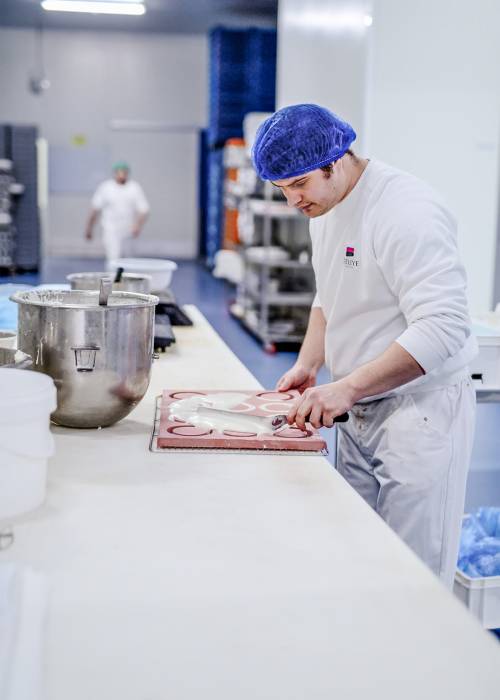
Starting over with frozen foods
A pastry chef by training, Deleye single-handedly set up his successful dessert business, which continues to grow steadily. As he explains, “At first, all I had was a little bakery where I sold bread and cakes. I supplied these cakes to the restaurants on the square – Sundays and holidays too. The restaurant owners usually showed up before the store opened.” Business was good, but it was also very stressful: Deleye worked through the weekends and had problems finding good employees. After three successful years, he took a leap of faith and started over with frozen foods in 1993 – with two employees and 200 square meters of space in a former textile factory. “At that time, our selection consisted of 13 cake rolls, which we later followed with tartlets. Both were frozen. It was quite a novelty at the time.”
With that product line, the entrepreneur was able to make his startup profitable. But the resourceful pâtissier wanted to expand more and was looking for new ideas. “I wanted to give my cakes new forms. After all, we are serving up a visual treat. Tasting good isn’t the only concern – it has to look good too.”
Deleye dreamed of 3D shapes – edible decorative balls, for example – that he could use to adorn traditional cakes in entirely new ways. But how could he produce them? He started out using thermoplastic molds. “But getting the cakes out of the mold was too hard. You had to wrap the tart in plastic film and then carefully remove it from its shell by pulling on the film. The plastic was also very stiff and often tore as it cooled.”
“I wanted to give my cakes new forms. After all, we are serving up a visual treat.”
Carlos Deleye, pastry chef
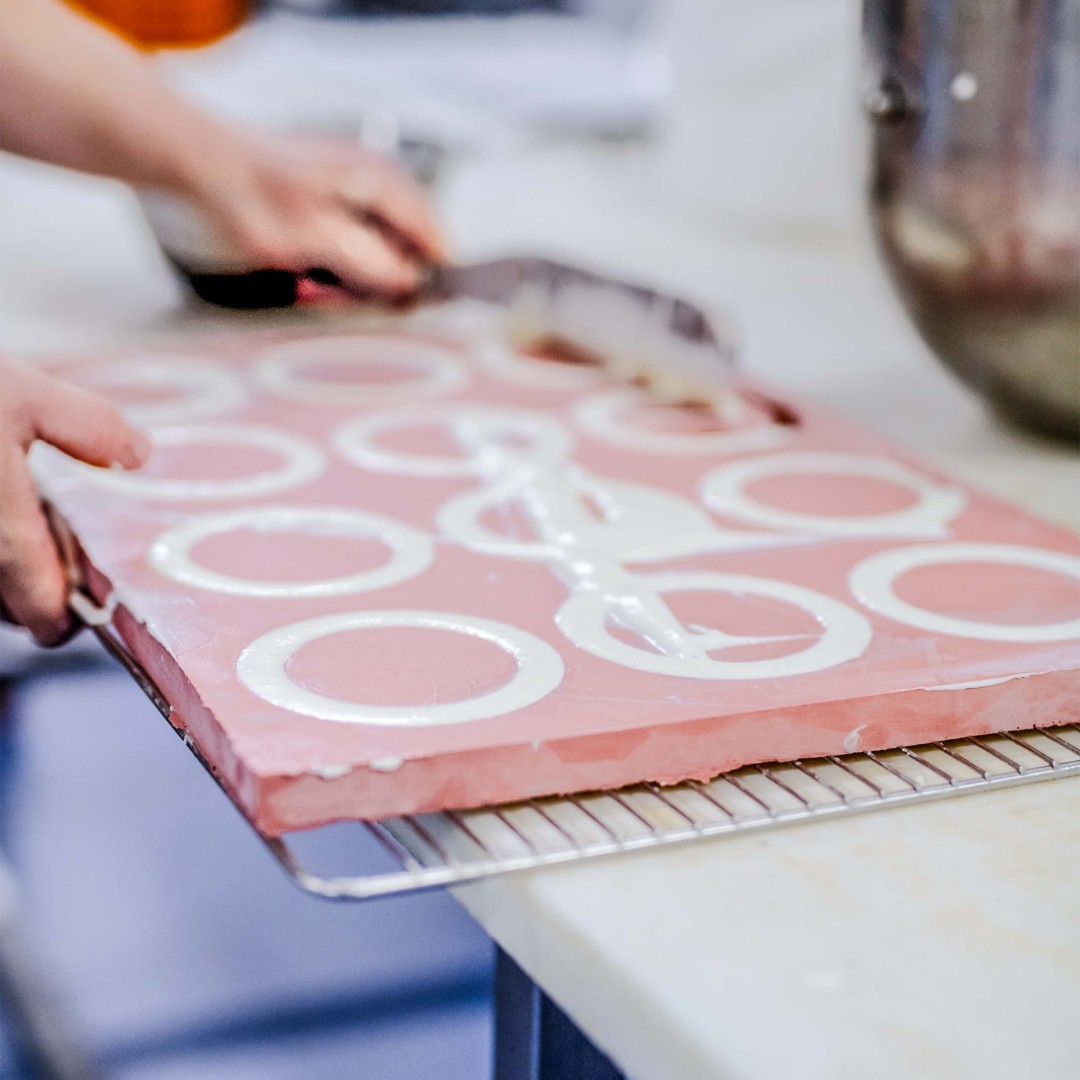
The Deleye employee needs barely 30 seconds to fill the silicone molds with the mascarpone mixture.
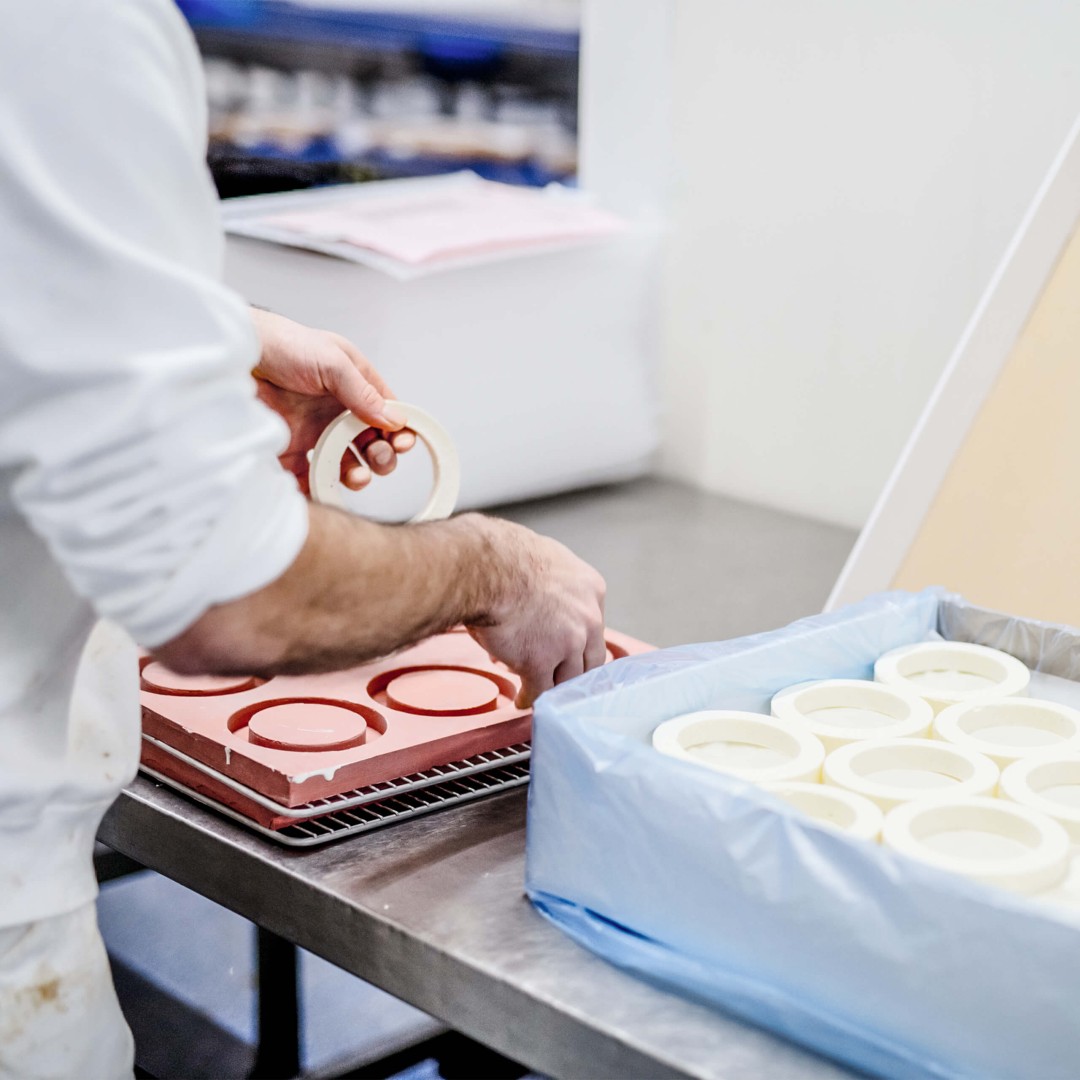
You need plenty of practice before you can push out the frozen mascarpone rings. You have to gently bend the edges of the silicone mold so as not to break the ring.
Trying out four blends
He discussed the problem with his friend Roger Van Damme, a well-known Michelin star chef from Belgium, who prompted Deleye to give silicone a try. “I didn’t really have much of a feel for the material, but I knew it could be used with food.”
Online research led Deleye to Tony Roex of the MCtechnics company, a distributor of raw materials for the composites industry, including silicones. One call was all it took to pique Roex’s interest. The silicone expert immediately traveled to Mouscron, taking various WACKER components with him. As Roex recalls, “We tried out four silicone blends. Some of the components we stirred in with egg beaters. I’d brought a vacuum pump with me just in case.”
It took a full year and a half to find the perfect silicone rubber compound. “A lot of our attempts failed or weren’t satisfactory. First it was too elastic, then it was too tough.” In the end, the ideal formulation for dessert production turned out to be ELASTOSIL® M 4601, a two-part, room-temperature-curing silicone rubber compound in which the A and B components are blended in a 9-to-1 ratio.
Deleye makes the dessert and baking molds in his factory himself by preparing a thermoplastic prototype on a 3D printer. He then uses the prototype to make a negative impression in the silicone. The company consumes some 600 kg of the elastic material each year and, for some time now, its founder has been thinking about installing various machines as a way of reducing the manual processes.
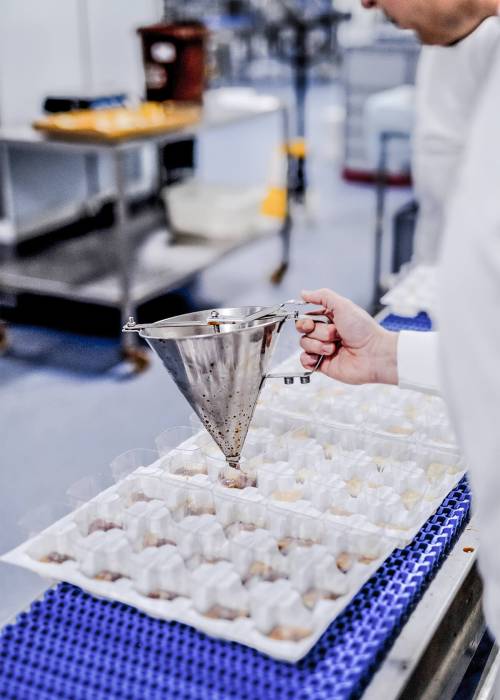
Even if the production line looks fairly industrial at first sight, all the desserts are still made by hand. Miniature tiramisus are being prepared here.
He’s hesitant about making the investment, but at the same time he’s also planning on expanding his wealth of molds even further over the coming years. “When I started out with silicone in 2014, I was a pioneer. But just three years later, Instagram and Pinterest were full of pictures of these desserts. If I’m going to defend my position as a trailblazer, I have to keep coming up with new ideas.” He’s constantly thinking up new designs, such as entrées in the shape of asparagus or mushrooms, or desserts shaped like keys. The father of two finds many of his ideas in toy stores or simply outdoors. To illustrate this point, he goes to his office and retrieves plastic and wooden toy vegetables from a grocery store play set for children. He also turns over a large, rough-edged stone in his powerful hand in an almost loving way. “I found this one when I was out for a walk and made a silicone cast from it. It was an experiment, and I’m not satisfied with the result yet.” His perfectionism is also what ensures his success: “A lot of restaurants have tried to make our molds themselves. But since they can’t match our quality, they’re still our customers.”
He currently uses eight different models to shape 40 different appetizers and desserts, most of which he still fashions in traditional 3D shapes like eggs, rings and various sizes of spherical decorations. “You can make about 100,000 decorative balls for desserts from a single silicone mold. The molds have a very long service life if you’re careful with them,” he explains with evident satisfaction. “You have to be particularly cautious when removing frozen treats from them,” he says. Gentle pressure quite literally pops the balls from their silicone envelopes, while carefully, skillfully bending the elastic mold at the edges and in the center releases the rings, which are then stacked in their packaging by hand. Of course, you need a certain amount of practice, explains Deleye, adding with pride: “My employees have that.”
“Silicone is no problem to cool and it’s easy to clean, and that means you can refill it faster.”
Carlos Deleye, pastry chef
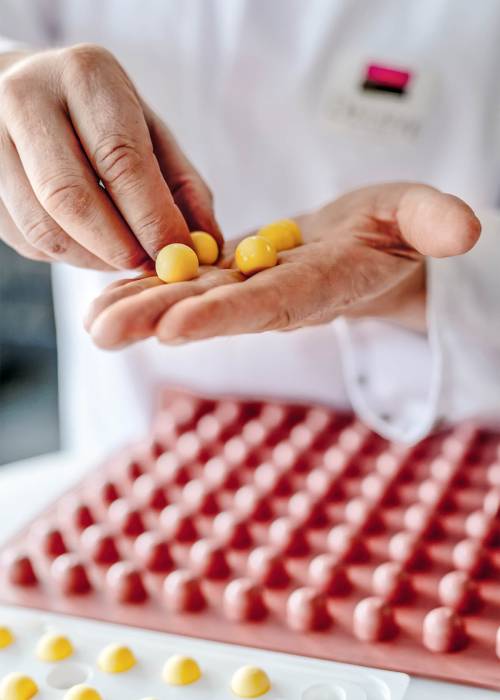
“Elements” – sweet spherical decorations – are among Deleye’s bestsellers. These miniature decorative balls are made in silicone molds and packaged by being lined up on square plastic pallets. The desserts shown here are made of mango and passion fruit.
Silicone boosts expansion
The 52-year-old Flemish pastry chef is generally satisfied with his selection of materials in other ways as well. As he himself has stated, they have really helped his company grow – and won him quite a few innovation awards: “Silicone is no problem to cool and it’s easy to clean, and that means you can refill it faster. Even the cost of acquisition and production is significantly below that of other baking molds.” Certain grades also meet the standards of the US Food and Drug Administration (FDA) and Germany’s Federal Institute for Risk Assessment (BfR), making them suitable for food contact. Are there really no disadvantages at all? “You have to look out for cracks. The desserts run out when that happens.”
Despite the fairly industrial atmosphere in the production halls at Mouscron, all of the desserts are still made by hand the old-fashioned way. The boss develops the recipes himself, while the six pâtissiers he employs oversee preparation. Only the finest ingredients are good enough. “We use nothing but Belgian chocolate from Callebaut, for example. Taht’s the very best chocolate there is. Our mascarpone comes straight from Italy, and our fruit, vegetables and herbs are completely fresh – we couldn’t get away with anything less today.” The company’s best sellers include “Elements,” which are spherical decorations flavored with caramel, mango/passion fruit, yuzu or basil and which range in diameter between 1 and 2.5 cm, and “Quenelles,” oval-shaped confections roughly 5 cm long and made of various types of chocolate and fruit. Also very well received are the company’s “Amelioras” – little round flavored decorations made of herbs and flowers, such as hibiscus, turmeric, basil or lemon grass, and used for appetizers and salads. As Deleye notes, “You couldn’t have made any of these products in the past, but they’ve made my company a top player and earned us awards. As far as I’m concerned, the future of gastronomy lies in the use of silicone.”
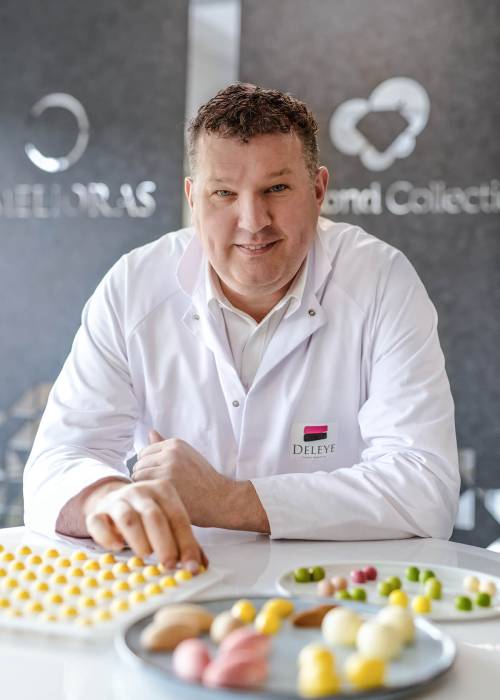
The innovative desserts that company founder Carlos Deleye creates have already won him several awards. What’s more, he is always on the lookout for new shapes.
Contact
For more information on this topic, please contact:
Mrs. Andrea Bogner
Senior Marketing Manager
Industrial Solutions WACKER SILICONES
+49 89 6279-1375
andrea.bogner@wacker.com

